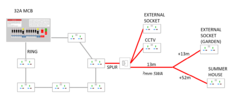I want to add a couple of sockets in the garden - one in a pergola area and the other in a summerhouse. Both relatively low draw, although I suspect we may use a 1kw heater for short periods of times in the summerhouse.
I was hoping to make use of an external socket / fused spur which is already outside the house, rather than having to pull more wires through the external house wall.

It's an odd (I think wrong) setup at the moment - I think both existing sockets should be off the fused spur.
I was proposing to feed the new sockets from the fused spur - is this ok?

Given the total runs (approx 26m to garden socket and 65m to summer house) I take it 2.5mm SWA won't be sufficient?
Thanks!
I was hoping to make use of an external socket / fused spur which is already outside the house, rather than having to pull more wires through the external house wall.
It's an odd (I think wrong) setup at the moment - I think both existing sockets should be off the fused spur.
I was proposing to feed the new sockets from the fused spur - is this ok?
Given the total runs (approx 26m to garden socket and 65m to summer house) I take it 2.5mm SWA won't be sufficient?
Thanks!


